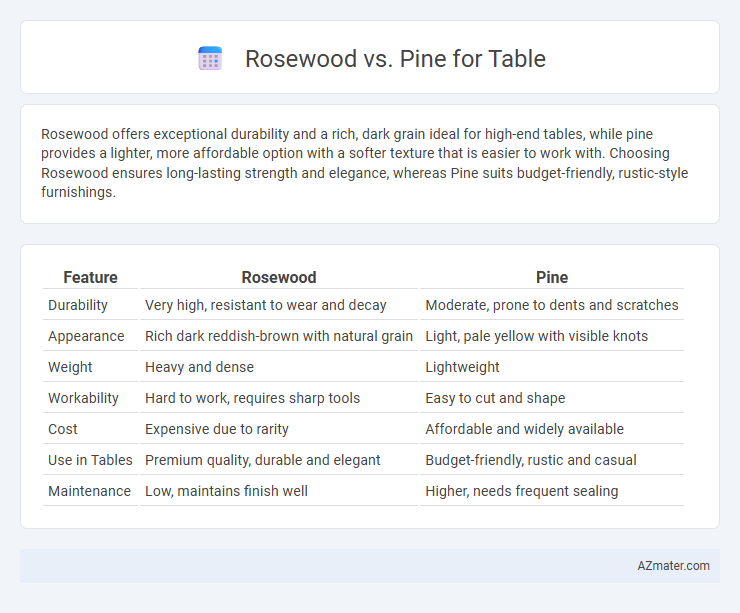Rosewood offers exceptional durability and a rich, dark grain ideal for high-end tables, while pine provides a lighter, more affordable option with a softer texture that is easier to work with. Choosing Rosewood ensures long-lasting strength and elegance, whereas Pine suits budget-friendly, rustic-style furnishings.
Table of Comparison
| Feature | Rosewood | Pine |
|---|---|---|
| Durability | Very high, resistant to wear and decay | Moderate, prone to dents and scratches |
| Appearance | Rich dark reddish-brown with natural grain | Light, pale yellow with visible knots |
| Weight | Heavy and dense | Lightweight |
| Workability | Hard to work, requires sharp tools | Easy to cut and shape |
| Cost | Expensive due to rarity | Affordable and widely available |
| Use in Tables | Premium quality, durable and elegant | Budget-friendly, rustic and casual |
| Maintenance | Low, maintains finish well | Higher, needs frequent sealing |
Introduction: Rosewood vs Pine for Tables
Rosewood and Pine are two popular choices for table construction, each offering distinct characteristics in terms of durability, appearance, and cost. Rosewood is prized for its rich, dark hues and natural oils that make it highly resistant to wear and decay, ideal for high-end furniture. Pine provides a lighter color and a softer texture, making it more affordable and easier to work with, but it requires more maintenance to prevent dents and scratches.
Wood Characteristics: Rosewood and Pine
Rosewood, known for its dense grain and rich reddish-brown hues, offers exceptional durability and natural resistance to decay, making it ideal for high-end tables requiring longevity and a luxurious finish. Pine is a softwood characterized by its light color and prominent knots, providing a rustic charm but less resistance to dents and scratches compared to Rosewood. The dense, oily texture of Rosewood enhances moisture resistance and polish retention, while Pine's softness allows easier shaping but demands more maintenance to prevent wear.
Appearance and Grain Patterns
Rosewood features rich, dark hues with striking reddish-brown tones and bold, swirling grain patterns that create a luxurious and dramatic appearance for tables. Pine offers a lighter, creamy yellow color with a more uniform and straight grain, often displaying knots that give a rustic and casual charm. The contrast between rosewood's dense, complex grains and pine's softer, simpler texture significantly influences the table's visual impact and style.
Durability and Hardness Comparison
Rosewood is significantly harder and more durable than pine, with a Janka hardness rating of around 2200 compared to pine's 380 to 870, making rosewood highly resistant to dents and scratches. The dense grain structure of rosewood also contributes to its superior longevity and ability to withstand heavy use, ideal for high-traffic tables. Pine, while softer and more prone to surface damage, offers flexibility and ease of repair but is less suitable for long-term durability when compared directly to rosewood.
Cost and Affordability
Rosewood tables typically cost significantly more than pine tables due to the rarity and durability of rosewood, which is a premium hardwood that commands higher prices. Pine tables offer a budget-friendly option, with lower material and production costs, making them accessible for those seeking affordability in furniture. Choosing pine can provide a cost-effective solution without sacrificing functionality, while rosewood represents an investment in luxury and long-term value.
Workability and Ease of Crafting
Rosewood offers a dense grain and natural oils that make it durable yet challenging to machine, requiring sharp tools and patience during crafting. Pine's softer texture and straight grain provide excellent workability, making it ideal for beginners or projects needing frequent shaping and sanding. Selecting between rosewood and pine depends on the desired balance between durability, finishing quality, and ease of crafting complexity.
Maintenance and Longevity
Rosewood offers superior durability and resistance to wear, requiring minimal maintenance compared to pine, which is softer and more prone to dents and scratches. Maintaining rosewood tables typically involves occasional polishing to preserve their natural luster, whereas pine tables often need more frequent refinishing and protection from moisture to prevent warping or discoloration. Longevity-wise, rosewood tables can last decades with proper care, while pine furniture tends to show signs of aging and damage more quickly due to its softer grain.
Environmental Impact and Sustainability
Rosewood is often sourced from slow-growing tropical trees, leading to significant deforestation and habitat loss, which raises concerns about its environmental impact and sustainability. Pine, a fast-growing softwood commonly harvested from managed forests, offers a more renewable and eco-friendly option due to its quicker regeneration and lower carbon footprint. Choosing pine over rosewood supports sustainable forestry practices and reduces the risk of contributing to endangered species depletion.
Best Uses: Rosewood Tables vs Pine Tables
Rosewood tables excel in durability and rich aesthetics, making them ideal for high-end furniture and heirloom pieces that require long-lasting strength and a luxurious finish. Pine tables are best suited for casual or rustic settings, offering affordability, light weight, and ease of customization for painted or distressed designs. For heavy-use environments or statement furniture, rosewood is preferred, while pine suits budget-conscious buyers seeking versatility and a warm, natural look.
Choosing the Right Wood: Final Considerations
Rosewood offers exceptional durability and a rich, dark grain that enhances the elegance of premium tables, making it ideal for long-lasting, high-end furniture. Pine is lightweight and affordable, with a softer texture that is easier to work with but prone to dents and scratches, suitable for casual or rustic-style tables. Consider factors like budget, desired aesthetics, and maintenance when choosing between rosewood's luxury appeal and pine's practicality for your table project.

Infographic: Rosewood vs Pine for Table
 azmater.com
azmater.com